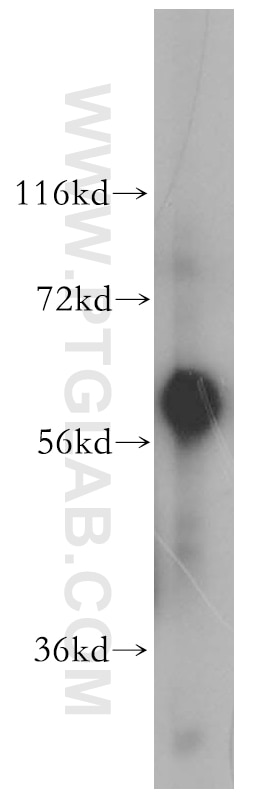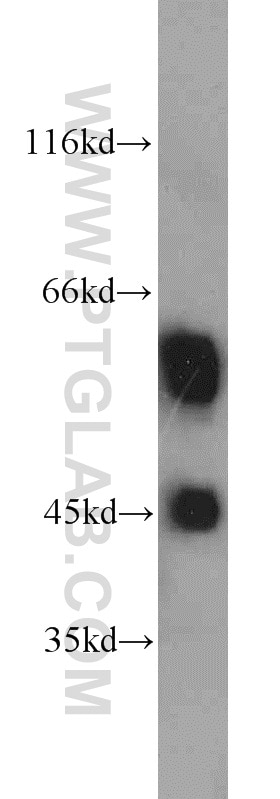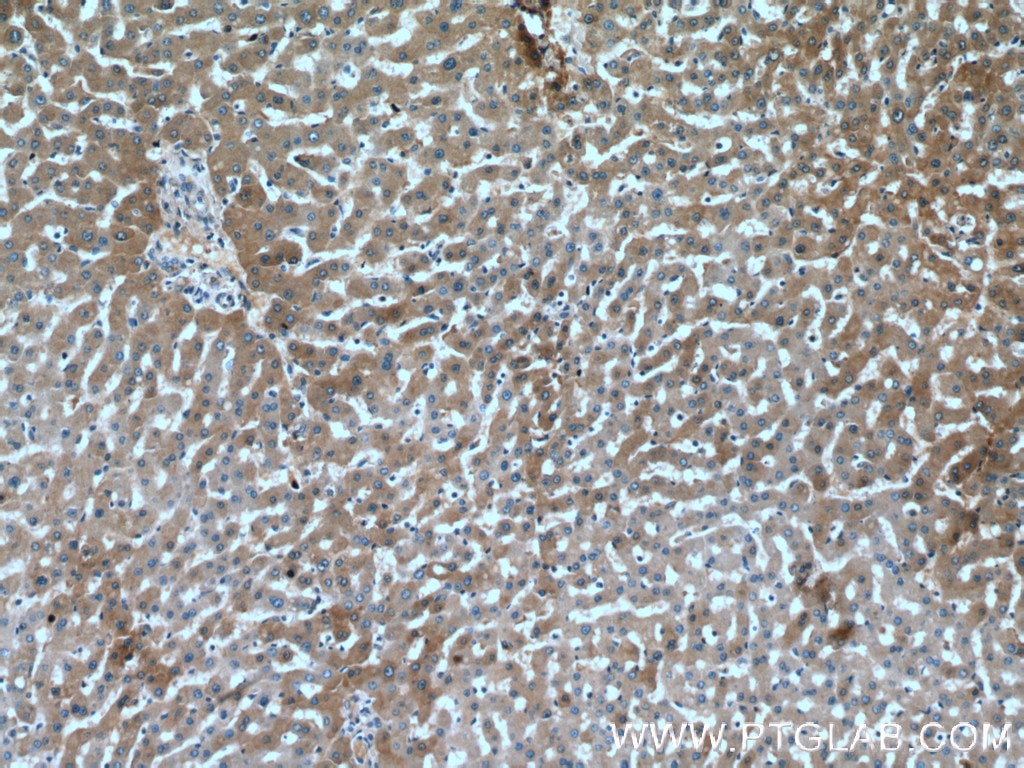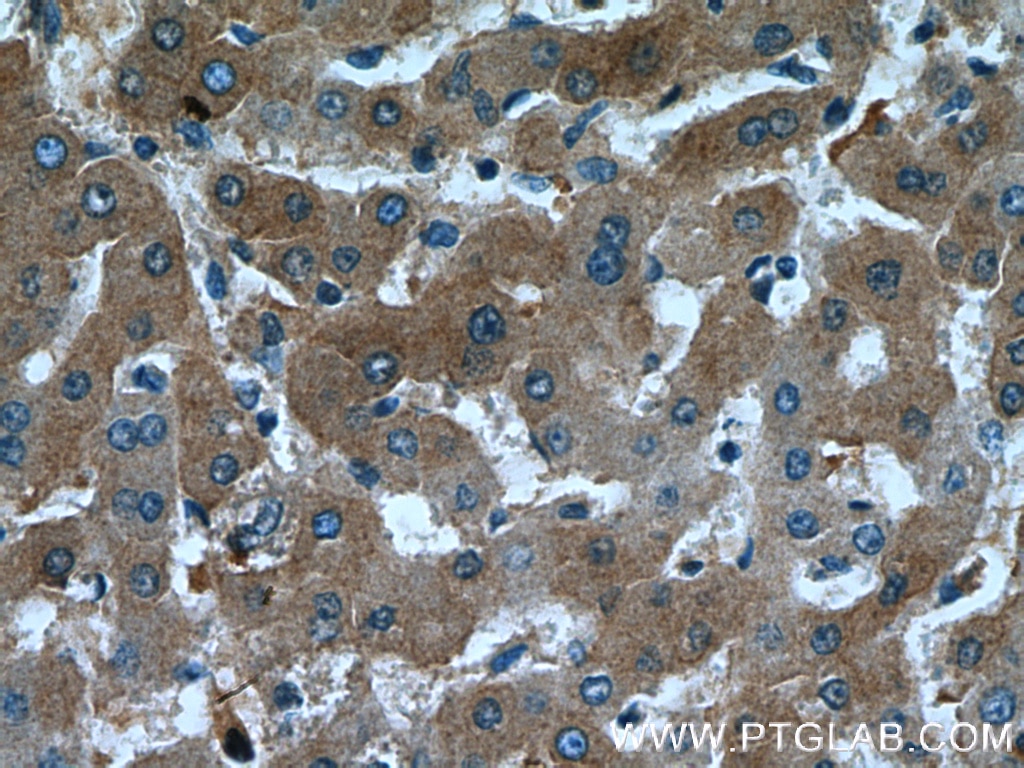Tested Applications
| Positive WB detected in | human liver tissue, human heart tissue |
| Positive IHC detected in | human liver tissue Note: suggested antigen retrieval with TE buffer pH 9.0; (*) Alternatively, antigen retrieval may be performed with citrate buffer pH 6.0 |
Recommended dilution
| Application | Dilution |
|---|---|
| Western Blot (WB) | WB : 1:500-1:1000 |
| Immunohistochemistry (IHC) | IHC : 1:50-1:500 |
| It is recommended that this reagent should be titrated in each testing system to obtain optimal results. | |
| Sample-dependent, Check data in validation data gallery. | |
Published Applications
| WB | See 6 publications below |
| IHC | See 2 publications below |
| IF | See 1 publications below |
Product Information
16571-1-AP targets Fetuin-A/AHSG in WB, IHC, IF, ELISA applications and shows reactivity with human samples.
| Tested Reactivity | human |
| Cited Reactivity | human, mouse, rat, plasmodium falciparum |
| Host / Isotype | Rabbit / IgG |
| Class | Polyclonal |
| Type | Antibody |
| Immunogen |
CatNo: Ag9853 Product name: Recombinant human AHSG protein Source: e coli.-derived, PGEX-4T Tag: GST Domain: 1-367 aa of BC048198 Sequence: MKSLVLLLCLAQLWGCHSAPHGPGLIYRQPNCDDPETEEAALVAIDYINQNLPWGYKHTLNQIDEVKVWPQQPSGELFEIEIDTLETTCHVLDPTPVARCSVRQLKEHAVEGDCDFQLLKLDGKFSVVYAKCDSSPDSAEDVRKVCQDCPLLAPLNDTRVVHAAKAALAAFNAQNNGSNFQLEEISRAQLVPLPPSTYVEFTVSGTDCVAKEATEAAKCNLLAEKQYGFCKATLSEKLGGAEVAVTCTVFQTQPVTSQPQPEGANEAVPTPVVDPDAPPSPPLGAPGLPPAGSPPDSHVLLAAPPGHQLHRAHYDLRHTFMGVVSLGSPSGEVSHPRKTRTVVQPSVGAAAGPVVPPCPGRIRHFKV Predict reactive species |
| Full Name | alpha-2-HS-glycoprotein |
| Calculated Molecular Weight | 367 aa, 39 kDa |
| Observed Molecular Weight | 58 kDa |
| GenBank Accession Number | BC048198 |
| Gene Symbol | Fetuin-A |
| Gene ID (NCBI) | 197 |
| RRID | AB_2224119 |
| Conjugate | Unconjugated |
| Form | Liquid |
| Purification Method | Antigen affinity purification |
| UNIPROT ID | P02765 |
| Storage Buffer | PBS with 0.02% sodium azide and 50% glycerol, pH 7.3. |
| Storage Conditions | Store at -20°C. Stable for one year after shipment. Aliquoting is unnecessary for -20oC storage. 20ul sizes contain 0.1% BSA. |
Background Information
Fetuin-A, also named as Alpha2-HS glycoprotein (AHSG), is a member of cystatin superfamily of protease inhibitors. It is a highly expressed glycoprotein in various fetal tissues whereas it is mainly expressed by the liver in adults. Fetuin A, an extracellular inhibitor of transforming growth factor β, is a profibrogenic stimulus in liver disease. Circulating fetuin-A may be a beneficial serum biomarker in the detection of liver and vascular fibrosis progression in patients with non-alcoholic fatty liver disease. It is also involved in several functions, such as endocytosis, brain development and the formation of bone tissue. Fetuin-A exerts its effects on the cardiovascular system by two different mechanisms. On the one hand it inhibits ins signaling and induces ins resistance contributing to the onset of atherosclerosis and on the other hand it inhibits calcium deposition and protects from vascular calcification.
Protocols
| Product Specific Protocols | |
|---|---|
| IHC protocol for Fetuin-A/AHSG antibody 16571-1-AP | Download protocol |
| WB protocol for Fetuin-A/AHSG antibody 16571-1-AP | Download protocol |
| Standard Protocols | |
|---|---|
| Click here to view our Standard Protocols |
Publications
| Species | Application | Title |
|---|---|---|
Front Cell Dev Biol Plasma Exosomes Derived From Patients With End-Stage Renal Disease and Renal Transplant Recipients Have Different Effects on Vascular Calcification. | ||
Osteoarthritis Cartilage Proteomics analysis of hip articular cartilage identifies differentially expressed proteins associated with osteonecrosis of the femoral head. | ||
J Pharm Biomed Anal Integrated cartilage metabolomics and proteomics analysis reveals the therapeutic effect of Wenjing Tongluo Decoction on Knee osteoarthritis rats | ||
Malar J The malaria parasite Plasmodium falciparum in red blood cells selectively takes up serum proteins that affect host pathogenicity. | ||
Bioengineered Alpha-2 Heremans Schmid Glycoprotein (AHSG) promotes the proliferation of bladder cancer cells by regulating the TGF-β signalling pathway. | ||
Free Radic Biol Med Hepatocyte-derived Fetuin-A promotes alcohol-associated liver disease in mice by inhibiting autophagy-lysosome degradation of TLR and M2 macrophage polarization |
Reviews
The reviews below have been submitted by verified Proteintech customers who received an incentive for providing their feedback.
FH S (Verified Customer) (11-20-2025) | Fetuin-A polyclonal antibody
|










